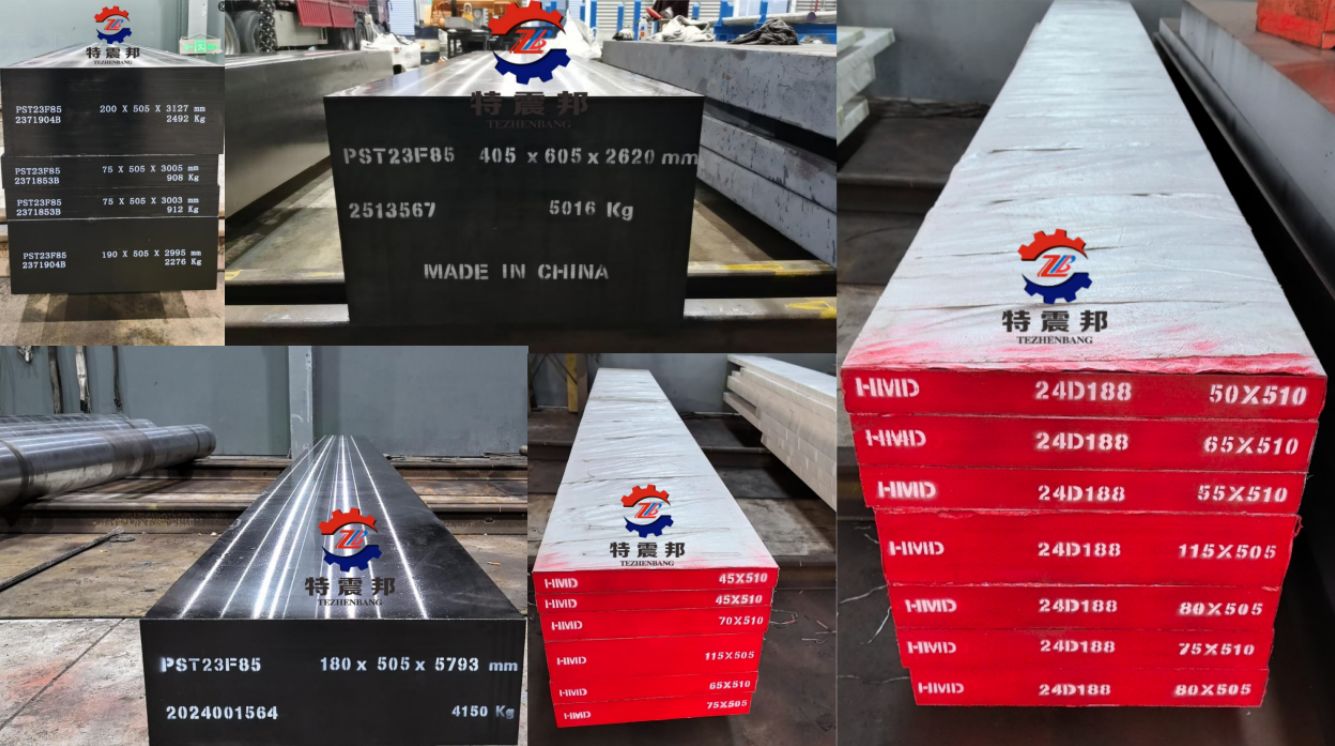PST23F85(7CrSiMnMoV, HMD, CH-1)
Classification:
Tel:
Detailed Introduction
| Steel Grade (Kor) |
Comparison of National Grades |
Technical Conditions |
Chemical Composition |
||||||||||||||
| C |
Cr |
Mo |
V |
S |
P |
Si |
Mn |
Ni |
W |
Al |
Cu |
Nb |
Co |
B |
|||
| PST23F85 |
Japan Daido (GO5) Japan Hitachi (HM5)
|
DIN EN ISO 4957-2001 |
0.80 ¦ 0.90 |
1.80 ¦ 2.20 |
0.20 ¦ 0.30 |
0.05 ¦ 0.10 |
≤0.010 |
≤0.030 |
0.80 ¦ 1.20 |
0.70 ¦ 1.10 |
≤0.25 |
|
0.15 ¦ 0.20 |
|
|
|
|
| Steel Grade (GB) |
Comparison of National Grades |
Technical Conditions |
Chemical Composition |
||||||||||||||
| C |
Cr |
Mo |
V |
S |
P |
Si |
Mn |
Ni |
W |
Al |
Cu |
Nb |
Co |
B |
|||
| 7CrSiMnMoV |
CH-1 |
GB/T 1299-2014 |
0.65 ¦ 0.70 |
0.90 ¦ 1.20 |
0.20 ¦ 0.50 |
0.15 ¦ 0.30 |
≤0.010 |
≤0.030 |
0.85 ¦ 1.15 |
0.65 ¦ 1.05 |
≤0.25 |
|
|
|
|
|
|
Product Introduction
PST23F85 It is a flame-quenched tool steel that undergoes surface heat treatment through flame. This heat treatment method can save costs while ensuring that the steel has high strength and surface wear resistance, mainly used for automotive bumper molds, punching molds, forming molds, cutting edge molds, and shear blades.
7CrSiMnMoV(HMD、CH-1)This steel is a flame-quenched steel used to manufacture large, complex cold work molds.7CrSiMnMoV(HMD、CH-1)The steel can be used for the edge of molds, heated to quenching temperature by oxygen-acetylene flame, and then air-cooled to achieve hardening. It has small deformation and does not require further processing. Molds treated with flame quenching have a longer service life compared to carbon tool steel and low-alloy mold steel, and can shorten the mold production cycle by 10%, reduce costs by 10% to 20%, and save about 80% of energy in heat treatment, opening up new avenues for efficient, low-cost, and energy-saving die manufacturing processes.Forging Process
The steel has low alloy content, no large excess carbides, low resistance to plastic deformation, and good forging performance. The forging heating temperature is 1150 to 1200℃, starting forging temperature is 1100 to 1150℃, and final forging temperature is 800 to 850℃. Due to the good hardenability of the steel, the surface hardness after forging can reach 50HRC, so it should be air-cooled after forging.
7CrSiMnMoV(HMD、CH-1)Annealing ProcessTo prevent decarburization, the annealing of the steel should be carried out in a protective atmosphere. The commonly used annealing process is to hold at 820 to 840℃ and then slowly cool to about 550℃ at a cooling rate of 20 to 30℃/h, followed by air cooling. If a satisfactory granular pearlite structure is required, it can be slowly cooled to 680 to 700℃ after heating and holding, isothermally held for 3 to 6 hours, and then slowly cooled.
The annealing hardness is
217 to 241HBS.7CrSiMnMoV(HMD、CH-1)Quenching and Tempering ProcessThe recommended overall quenching and tempering process is: after heating uniformly at 900 to 920℃, oil quenching or graded quenching in 220℃ nitrate salt, tempering at 190 to 200℃ for 1 to 3 hours, with a hardness of 58 to 62HRC.
Flame Quenching Process: Flame heating and air cooling quenching can be performed using single or double nozzle flames to achieve a hardness of 58HRC. When using a double nozzle, the hardened layer depth can reach 5 to 6mm; with a single nozzle, the hardened layer depth is generally 2 to 3mm.Mechanical Properties
Compared with commonly used mold steels 9Mn2V, CrWMn, Cr12MoV, the steel has a significant advantage in toughness. Flame quenching can give the surface high hardness, high toughness in the core, and the mold is less likely to crack or chip, while the surface hardened layer forms compressive stress, which can significantly improve fatigue strength and extend the service life of the mold.
Application RangeUsing flame heating and quenching has advantages such as simple equipment, convenient operation, and high productivity, and solves the problem of local quenching of large molds.
火焰淬火工艺:可用单头或双头喷嘴火焰加热空冷淬火,获得58HRC的硬度。采用双头喷嘴时,淬硬层深度可达5~6mm;用单头喷嘴时,淬硬层深度一般为2~3mm
力学性能
与常用模具钢9Mn2V、CrWMn、Cr12MoV比较,7CrSiMnMoV(HMD、CH-1)钢的强韧性占明显优势。火焰淬火能使表面获得高硬度、心部高韧性、模具不易发生开裂、崩刃等,同时表面硬化层形成压应力,可显著提高疲劳强度,延长模具使用寿命。
应用范围
采用火焰加热淬火具有设备简单、操作方便、生产率高等优点,并解决了大型模具表面局部淬火的难题。CH-1 steel has been widely used in standard parts, bearings, electronics, automotive and other industries. Replacing T10A, 9Mn2V, CrWMn, Cr12MoV steel with CH-1 steel for the production of cold work molds such as blanking molds, punching molds, trimming molds, bending molds, shaping molds, deep drawing molds, and cold heading molds, which require high toughness, can increase the lifespan by more than 1 to 3 times.
Product image

key word:
Hot working mold steel
Cold working mold steel
Plastic mold steel
Forging series
Message Consultation
Service hotline:
Company address
Telephone
Address: No.128 Zhangzhihe Avenue, Dapaishan Village, Xisaishan District, Huangshi City, Hubei Province

